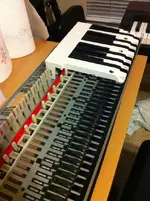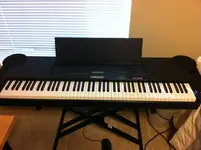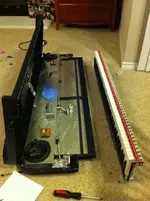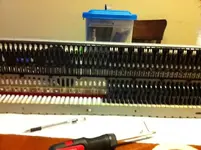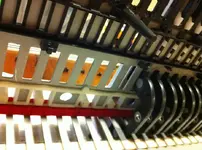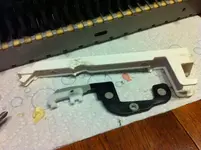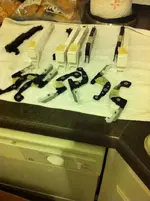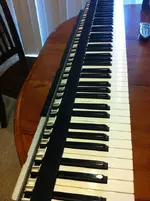Reassembly
Here is a photo of the grease Yamaha sent me. The larger tube is a white substance, a bit runny, meant for the center posts, and the middle pivot points. The small container is a blue, paste-like substance that reminds me of blue wasabi. This is meant for the back of the key, at the fulcrum.
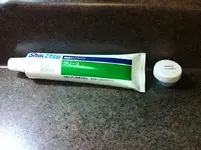
Before starting I had to prepare the keyboard frame. It was fairly dirty still, even after all my prior cleanings. There was a good bit of grease on the key posts, but this grease was not quite as broken down and tar-like as the ones that was on the keys. Also, I didn't want to have to re-felt the thing, so instead of giving it the soapy water and toothbrush treatment, I opted for the "good enough for rock-and-roll" approach, and used several pieces of masking tape to clean the felt like a lint roller. I also used masking tape to wipe any major debris from the key posts. I also "flossed" between them, a bit like flossing an 88-toothed alligator:

More pics of the fresly-cleaned key frame:
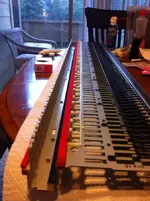
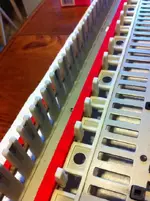
Next I had to figure out which side was key 1 and which was key 88. This was a lot of trial and error but I got it right eventually. It also helped that each and every key and counterweight had been previously labelled with masking tape, 1 though 88.
First I had to take the counterweight and apply the white colored grease to the center mechanism. I used a toothpick for this, and applied a small amount to the sides of the key post.
-- I weaved the counterweight in, and then put a small amount of white grease on the center pivot point on the key. I also put a tiny amount of the blue fulcrum grease on the back of the key using a toothpick. I then installed the key on top of the counterweight. This takes care, as there are lots of nooks and crannies. But it was relatively easy. Then I reinserted the spring.
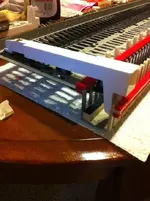
This is when I almost crapped my pants with grief. The KEY STILL STUCK! WHAT WAS GOING ON??
Well as it turned out, I had not yet reinstalled the rubber key contacts. The key contacts provide the added "spring" when the key hits the bottom which pops the key back up after it goes down. Otherwise, without the key contact, the key was going down too far, and hitting all the soft squishy felt on the bottom, and not going back up. Reinstalling the key contact strips and board, the key felt like new again. I found that I did not have to wait to reinstall the key contact boards, and could reinstall them right away. I can reinstall the keys even while the key contacts are still in place.
So far I've gotten just over an octave done:
